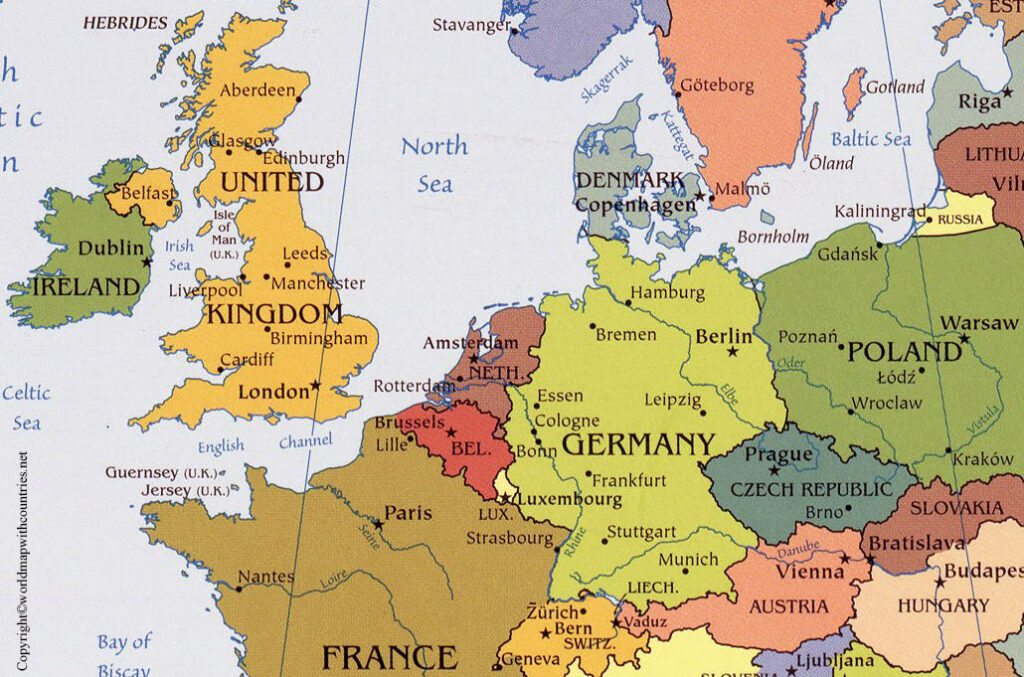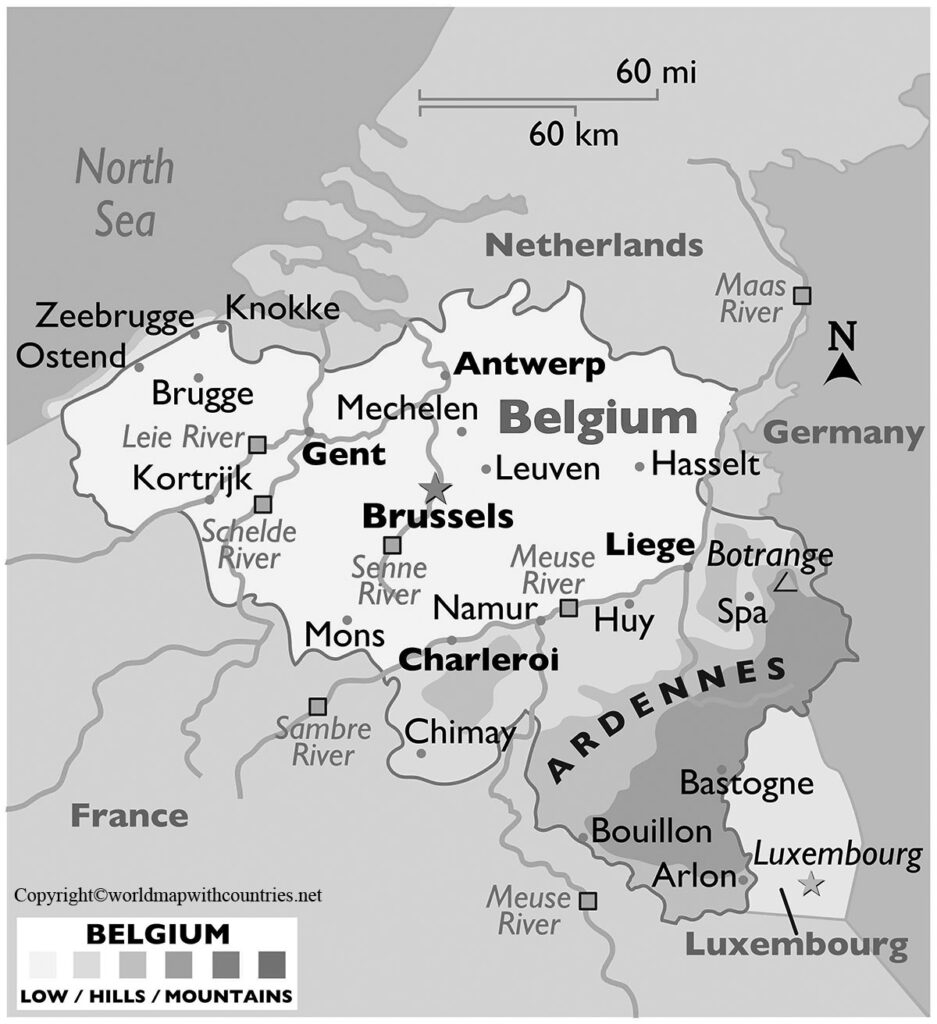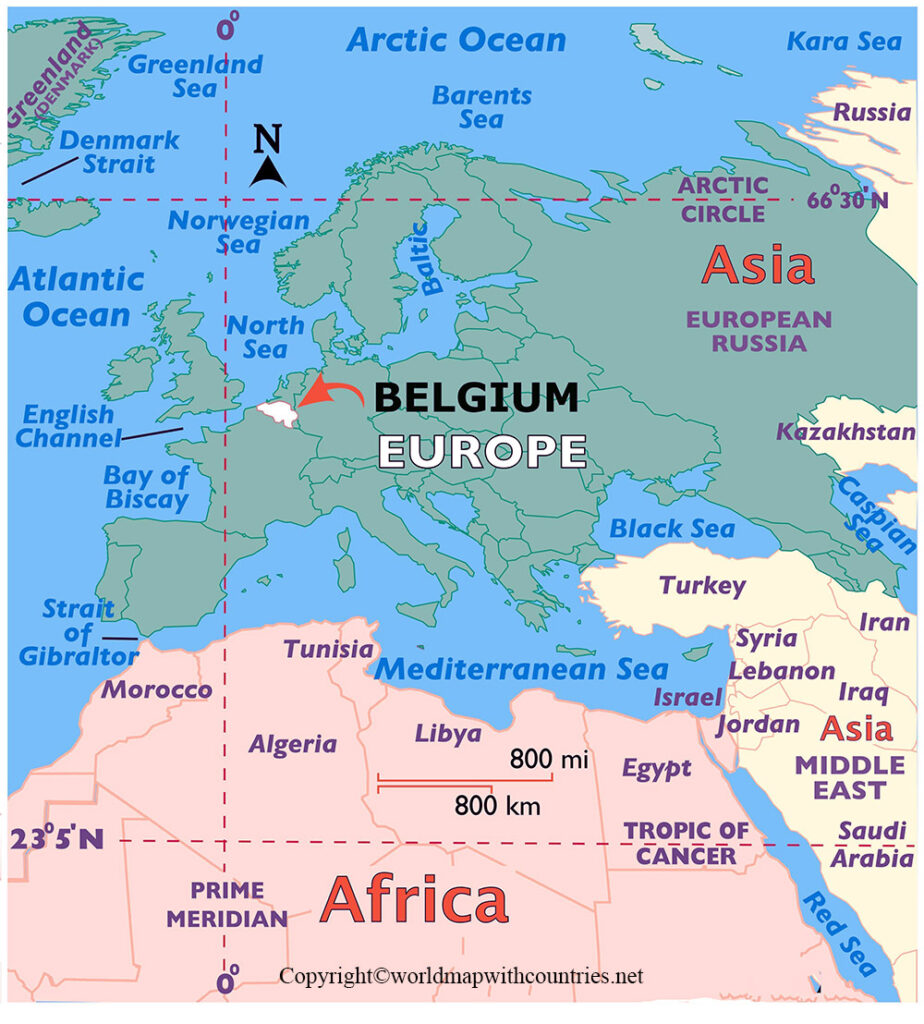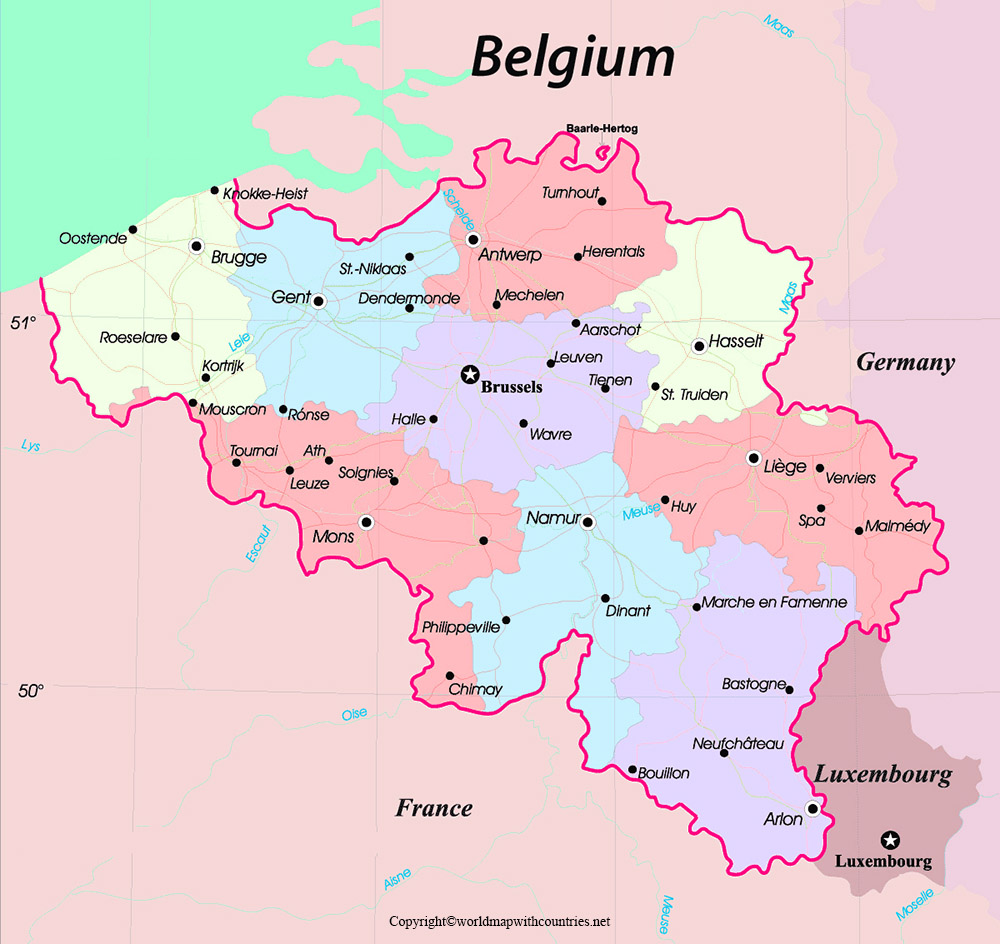Learn about the map of Belgium with the given Free Printable Labeled and Blank map of Belgium in PDF. Belgium is a small, primarily low elevation country in Western Europe. Out of its total population of 11 million predominantly Roman Catholic people, roughly 40 per cent are French-speaking Walloons, and 60 per cent are Dutch-speaking Flemish people. France borders Belgium to its west, The Netherlands to its north Germany to its east, and Luxembourg to its southeast. You can also see more on the printable world map pdf.
Table of Contents
Belgium on World Map with States
Regions of Belgium
The Regions of Belgium
Blank Map of Belgium
Labelled Map of Belgium
Printable Map of Belgium
Belgium Geography and Facts
Governance in Belgium
Climate in Belgium
Religion in Belgium
Demographic Trends in Belgium
Economy of Belgium
Belgium on World Map with States
The Belgium Map with States will show you that Belgium has a short coastline along the north sea and shares a maritime border with the United Kingdom. Due to its location right between France and Germany. Belgium was the site of several horrendous battles during both World Wars. One and World War two that caused significant damage there. Belgium was part of the kingdom of the Netherlands up until it gained independence in 1830, and that’s why much of traditional Belgian architecture seemed so reminiscent of that country.

During the 19th and 20th centuries. Belgium was a significant colonial power, and the kingdom controlled a vast amount of territory in southern Africa. Today Belgium is the center of the international diamond trade and is an industrialized country with a high standard of living. Belgium’s largest city and the national capital is Brussels seen here.
Regions of Belgium
Belgium is a federal state with three communities, three regions and four languages. The establishment date of language divisions is 2 August 1963, Second Gilson Act. The division into language territories was a subject in the Belgian Constitution in 1970. Through constitutional reforms in the 1970s and 1980s, federal, regional and community governments were formed.
The three communities of Belgium are:
- the Dutch-speaking Flemish Community (Vlaamse Gemeenschap),
- the French-speaking French Community (Communauté française), and
- the German-speaking German-speaking Community (Deutschsprachige Gemeinschaft, DG)
The three regions in Belgium are:
- the Brussels-Capital Region (Brussels, Région de Bruxelles-Capitale in French, Brussels Hoofdstedelijk Gewest in Dutch),
- the Flemish Region (Flanders, Vlaams Gewest) and
- the Walloon Region (Wallonia, Région wallonne).
The Regions of Belgium
- Flemish Region: The population by the 2017 census is 6,516,011. The surface area is 13,522 square kilometers. The Flemish region consists of 308 municipalities in total. The region’s official language is Dutch.
- Walloon Region: According to the population census of the year 2017, the population is 3,614,473—area, 16.844 km². Moreover, the Walloon region consists of 262 municipalities in total. In the Walloon region, German and French are the official languages. And also, Dutch is spoken for only administrative purposes in some areas.
- Brussels-Capital Region: The population by the 2017 census is 1,191,604. The surface area is 161 square kilometers. Brussels-Capital region consists of 19 municipalities in total. Official languages are French and Dutch.

Blank Map of Belgium
Brussels is also the headquarters of the European Union, a powerful political alliance promoting free trade and freedom of movement within its member countries. Belgium itself is a constitutional monarchy with a federal parliamentary system of government. Politically, the nation is divided into three central regions. Dutch-speaking Flanders in the North, French-speaking Wallonia in the south, and the small Brussels capital region surrounding that city. Download the blank Map of Belgium for both educational and personal purposes.

Labelled Map of Belgium
In Belgium, significant ethnic tensions exist between its French and Dutch speaking people, mainly over issues of economic and social equality. The labelled Map of Belgium shows that Belgium consists of three central regions. The first is its flat coastal plain in the north. The second is its intermediary slightly elevated central plateau, and the third region is the Ardan Uplands in its southeast.

Printable Map of Belgium
This hilly territory is by far the most forested region in the country and is where some of the most bloody battles of world war one and world war two were fought. Belgium’s two main rivers are the sheet and the muse. The country has a relatively mild maritime climate with moderate precipitation throughout the year.
Belgium Geography and Facts
Belgium is one of the countries in the north-western part of Europe. France, Germany, Luxembourg and the Netherlands have borders by governments of about 31 thousand square meters.
- Population: 11,533,459
- Population Density: 382 per Km2
- Land Area: 30,280 Km ²
Belgium is a welfare center in terms of trade and cultural history. Its name is a mixture of Celtic and Germanic. Furthermore, the country, which is mainly known for undertaking the administration of the European Union, is attracting significant interest from the Middle Ages and Renaissance works.
Belgium’s neighbors are France, Germany, Luxembourg, and the Netherlands, which have coasts on the Atlantic Ocean in the northwest. Covering an area of 33,990 square kilometers together with inland waters, the country covers an area of 30,528 square kilometers outside the inland waters. Belgium has three central geographical regions. The north-western coastal plains of the Anglo-Belgian Basin and Ardennes land are part of the central plateau and the southeast Hercynian orogenic belt. On the country’s southern tip, the Paris Basin reaches a fourth small area named Lorraine of Belgium.
Governance in Belgium
Although the Kingdom of Belgium was founded by the Constitution of 1831 with a state structure, it turned to a more federal system with the constitutional reforms of 1970, 1980, 1988/89, 1993, 2001 and lastly in 2011. There are six governments in the country, each controlled by a separate legislative body.
- Federal Government
- Flemish Government
- Valencian Government
- Brussels-Capital Territory Government
- French Community Government
- German Community Government
According to the original constitutional structure of Belgium, the federal government has no authority over the national units; the federal departments have no control over the federal government. The federal government’s legislation and the legislation of the federated units are considered equal. The regional and community parliamentary powers have the power to determine both their structures and the structure of the relevant provincial and district government.
Climate in Belgium
Belgium has a temperate, maritime climate predominantly influenced by air masses from the Atlantic. The rapid and frequent alternation of different air masses separated by fronts gives Belgium considerable variability in weather. Frontal conditions moving from the west produce heavy and frequent rainfall, averaging 30 to 40 inches (750 to 1,000 mm) a year. Winters are damp and cool with regular fogs; summers are relatively mild. The annual mean temperature is around 50 °F (10 °C). Brussels, which is roughly in the middle of the country, has a mean minimum temperature of just below 32 °F (0 °C) in January and a mean maximum of about 71 °F (22 °C) in July.
Regional climatic differences are determined by elevation and distance inland. Further inland, maritime influences become weaker, and the climate becomes more continental, characterized by greater seasonal extremes of temperature. The Ardennes region, the highest and farthest inland, is the coldest. In winter, frost occurs on about 120 days, snow falls on 30 to 35 days, and January means minimum temperatures are lower than elsewhere. In summer, the elevation counteracts the effect of distance inland, and July means maximum temperatures are the lowest in the country. Because of the topography, the region has the highest rainfall in Belgium.
In contrast, the Flanders region enjoys generally higher temperatures throughout the year. There are fewer than 60 days of frost and fewer than 15 of snow. On the seacoast, these figures are reduced to below 50 and 10, respectively. There are a few hot days, especially on the coast, where the annual rainfall is the lowest in the country.
Religion in Belgium
A large majority of Belgium’s population is Christians. Here is a complete list of all religions in Belgium:
- Catholics: 58.1%
- Item: 3%
- Islam: 3.6%
- Protestantism: 1.1%
- Orthodox: 0.6%
- Buddhism: 0.3%
- Judaism: 0,2%
- Industry and Tourism
Belgium’s strongly globalized economy and transport infrastructure are integrated with the rest of Europe. The country’s position at the heart of the advanced industrializing region has helped the world become the 15th largest trading country in 2007. It has characterized economy, labor, high GNP and high per capita exports.
The main export products of Belgium are food products, machinery, raw diamonds, petroleum and petroleum products, chemicals, clothing and accessories, and textile products. In contrast, the main export products are automobiles, food products, iron and steel, processed diamonds, textile, plastic, petroleum products and non-metals.
Apart from my impression that Belgium is a small country, it amazes everyone, rich and wonderful. Medieval and Art-Nouveau style architecture and a long history attract many tourists to the country. Furthermore, the best time to travel is from May to September.
Demographic Trends in Belgium
The annual growth rate of the Belgian population is meagre; overall, birth rates and immigration exceed death rates and emigration only slightly. Population growth rates, markedly higher in Flanders than in Wallonia before the 1980s, became nearly equivalent by the end of the 20th century. There was considerable rural-to-urban migration throughout the 20th century. The institution of policies that made Wallonia and Flanders officially unilingual regions significantly reduced migration between those two regions, but there is considerable migration within language regions. The emigration rate is low. Most of those who emigrate go to other EU countries or the United States.
Since World War II, the foreign-born population has increased higher than Belgian nationals due to continued immigration and a higher birth rate among immigrants. The largest concentrations of foreigners are found in the cities of the Walloon mining and industrial areas in Brussels and Antwerp. Foreign workers are of Mediterranean origin (primarily Italian, Middle Eastern, and North African). A modest number of these guest workers return to their countries of origin each year.
Economy of Belgium
Belgium has a free-enterprise economy, with most of the gross domestic product (GDP) generated by the service sector. The Belgian economy also is inextricably tied to that of Europe. The country has been a member of various supranational organizations, including the Belgium-Luxembourg Economic Union (BLEU), the Benelux Economic Union, and the EU. The first significant step Belgium took in internationalizing its economy occurred when it became a charter member of the European Coal and Steel Community in 1952. On January 1, 1999, Belgium also became a charter member of the European Monetary Union, paving the way for introducing the euro, which became the country’s sole currency in 2002, replacing the Belgian franc.
Historically, Belgium’s national prosperity was mainly dependent on the country’s role as a fabricator and processor of imported raw materials and the subsequent export of finished goods. The country became a major steel producer in the early 19th century, with factories centered in the southern Walloon coal-mining region, particularly in the Sambre-Meuse valley. Rigorous monetary reform aided Belgium’s post-World War II recovery and expansion, particularly in the Flemish light manufacturing and chemical industries that developed rapidly in the north, and Belgium became one of the first European countries to reestablish a favorable balance of trade in the postwar world. By the late 20th century, however, coal reserves in Wallonia were exhausted, the aging steel industry had become inefficient, labor costs had risen dramatically, and foreign investment (multinational companies control a significant portion of the country’s industrial assets) had declined.
The government, in an effort to reverse the near-depression levels of industrial output that had developed, subsidized ailing industries, particularly steel and textiles, and offered tax incentives, reduced interest rates, and capital bonuses to attract foreign investment. These efforts were moderately successful, but they left Belgium with one of the most significant budget deficits in the gross national product in Europe. The government was forced to borrow heavily from abroad to finance foreign trade (i.e., importing foreign goods) and sustain its generous social welfare system. In the early 1980s, the government attempted to reduce the budget deficit; the debt-to-GDP ratio decreased the central bank implemented tighter monetary and fiscal policies. Moreover, in the early 1990s, the government dropped its subsidy to the social security system. By the early 21st century, Belgium had diversified its sources of social-security funding and succeeded in balancing its budget. Regionally, Flanders has attracted a disproportionate share of investment, but the national government has offered subsidies and incentives to encourage investment within Wallonia. Unemployment also has been less of a problem in Flanders, which has experienced significant growth in service industries, than in Wallonia, where the negative consequences of deindustrialization remain.

